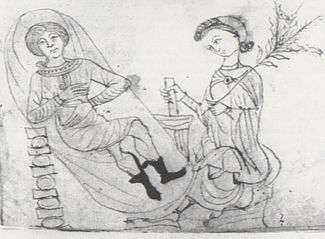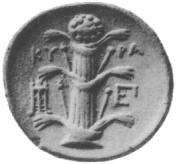Abortifacient

An abortifacient ("that which will cause a miscarriage" from Latin: abortus "miscarriage" and faciens "making") is a substance that induces abortion. Abortifacients for animals that have mated undesirably are known as mismating shots.
Common abortifacients used in performing medical abortions include mifepristone, which is typically used in conjunction with misoprostol in a two-step approach.[1] There are also several herbal mixtures with abortifacient claims, though there are no available data on the efficacy of these plants in humans.[2]
Pharmaceutical abortifacients
Prostaglandin analogues, such as misoprostol or gemeprost[3] (both synthetic prostaglandin E1 (PGE1) analogues), are often used to terminate pregnancy up to 24[4] or 60[3] days of gestation, in combination with mifepristone (a progesterone receptor antagonist) or methotrexate (an antifolate). Misoprostol administered vaginally is more effective than when administered orally.[5] Misoprostol is approved in France under the trade name GyMiso for use with mifepristone for medical abortion. Misoprostol is used off-label with mifepristone for medical abortion in the U.S. Dinoprostone, given by the extra-amniotic route, can be used for late abortion (second trimester).[3]
Mifepristone is a progesterone receptor antagonist also known as RU-486. It is marketed under the trade name Mifegyne in France and countries other than the U.S., and under the trade name Mifeprex in the U.S. It is used in conjunction with a prostaglandin analogue.
Misoprostol alone is sometimes used for self-induced abortion in Latin American countries where legal abortion is not available, and by poor people in the United States for whom it is easier or cheaper than a legal abortion in a clinic.[6]
Natural abortifacients
Numerous non-pharmaceutical abortifacients existed during the pre-pharmaceutical era. These included herbal, mineral, and ritualistic or spiritual preparations. Their effectiveness is difficult to determine, as almost all such uses occurred before the days of clinical trials and the scientific method. Of those that remain in use in the modern day, some are considered effective to a lesser or greater degree; while others are very effective, but carry negative side effects (primarily toxicity) which keep them from wider prevalence.
Today, many herbs and plants sold "over the counter" are claimed to act as abortifacients, either by themselves or if taken in certain doses or mixtures. Examples include brewer's yeast,[7] vitamin C, bitter melon,[8] wild carrot, blue cohosh, pennyroyal, nutmeg, mugwort, papaya, vervain, common rue, ergot, saffron and tansy. Animal studies have shown that pomegranate may be an effective abortifacient.[2][9]
History
In the Bible, the ordeal of the bitter water is prescribed for a sotah, or a wife whose husband suspects that she was unfaithful to him. The wife drinks "water of bitterness," which, if she is guilty, causes the abortion or miscarriage of a pregnancy she may be carrying.[10][11][12][13][14][15][16]

The ancient Greek colony of Cyrene at one time had an economy based almost entirely on the production and export of the plant silphium, considered a powerful abortifacient.[17] Silphium figured so prominently in the wealth of Cyrene that the plant appeared on coins minted there. Silphium, which was native only to that part of Libya, was overharvested by the Greeks and was effectively driven to extinction.[17] The standard theory, however, has been challenged by a whole spectrum of alternatives (from an extinction due to climate factors, to the so-coveted product being in fact a recipe made of a composite of herbs, attribution to a single species meant perhaps as a disinformation attempt).
In aboriginal Australia, plants such as cymbidium madidum, petalostigma pubescens, Eucalyptus gamophylla were ingested or the body or vagina was smoked with Erythropleum chlorostachyum.[18]
As Christianity and in particular the institution of the Catholic Church increasingly influenced European society, those who dispensed abortifacient herbs found themselves classified as witches and were often persecuted in witch-hunts.[19]
Medieval Muslim physicians documented detailed and extensive lists of birth control practices, including the use of abortifacients, commenting on their effectiveness and prevalence. The use of abortifacients was acceptable to Islamic jurists provided that the abortion occurs within 120 days of conception, the time when the fetus is considered to become fully human and receive its soul.[20]
In English law, abortion did not become illegal until 1803. English folk practice before and after that time held that fetal life was not present until quickening. "Women who took drugs before that time would describe their actions as 'restoring the menses' or 'bringing on a period'."[21] Abortifacients used by women in England in the 19th century (not necessarily safe or effective) included diachylon, savin, ergot of rye, pennyroyal, nutmeg, rue, squills, and hiera picra.[22]
See also
- Methotrexate
- Georg Eberhard Rumphius – documented some claims of abortifacient properties of herbs[23]
References
- ↑ Planned Parenthood. "The Abortion Pill (Medication Abortion)". Archived from the original on 7 February 2009. Retrieved 2009-01-22.
- 1 2 Riddle, John M. (1992). Contraception and Abortion from the Ancient World to the Renaissance. Cambridge, MA: Harvard University Press ISBN 0-674-16876-3.
- 1 2 3 Rod Flower; Humphrey P. Rang; Maureen M. Dale; Ritter, James M. (2007). Rang & Dale's pharmacology. Edinburgh: Churchill Livingstone. ISBN 0-443-06911-5.
- ↑ Bartley J, Brown A, Elton R, Baird DT (October 2001). "Double-blind randomized trial of mifepristone in combination with vaginal gemeprost or misoprostol for induction of abortion up to 63 days gestation". Human reproduction (Oxford, England). 16 (10): 2098–102. doi:10.1093/humrep/16.10.2098. PMID 11574498. Retrieved 2008-10-29.
- ↑ Kulier R, Gülmezoglu AM, Hofmeyr GJ, Cheng LN, Campana A (2004). Kulier R, ed. "Medical methods for first trimester abortion". Cochrane Database Syst Rev (2): CD002855. doi:10.1002/14651858.CD002855.pub3. PMID 15106180.
- ↑ John Leland: "Abortion Might Outgrow Its Need for Roe v. Wade", The New York Times, October 2, 2005
- ↑ King's American Dispensatory of 1898
- ↑ A Woman's Book of Choices: Abortion, Menstrual Extraction, RU-486 by Rebecca Chalker and Carol Downer
- ↑ Riddle, John M. (1997). Eve's Herbs: A History of Contraception and Abortion in the West. Cambridge, MA: Harvard University Press ISBN 0-674-27026-6.
- ↑ Gordon, R.P. (2007). The God of Israel. Cambridge University Press. p. 128.
- ↑ Berquist, Jon L. (2002). Controlling Corporeality: The Body and the Household in Ancient Israel. Rutgers University Press. pp. 175–177. ISBN 0813530164.
- ↑ Levine, Baruch A. (1993). Numbers 1-20: a new translation with introduction and commentary. 4. Doubleday. pp. 201–204. ISBN 0385156510.
- ↑ Snaith, Norman Henry (1967). Leviticus and Numbers. Nelson. p. 202.
- ↑ Olson, Dennis T. (1996). Numbers: Interpretation: A Bible Commentary for Teaching and Preaching. Westminster John Knox Press. p. 36. ISBN 0664237363.
- ↑ Brewer, Julius A. (October 1913). "The Ordeal in Numbers Chapter 5". The American Journal of Semitic Languages and Literatures. 30 (1): 46.
- ↑ Biale, Rachel (1995). Women and Jewish Law: The Essential Texts, Their History, and Their Relevance for Today. Random House Digital. p. 186. ISBN 0805210490.
- 1 2 Chip Rossetti, Devil’s Dung - The World’s Smelliest Spice, Saudi Armaco World, 2009
- ↑ Bush food: Aboriginal food and herbal medicine by Jennifer Isaacs
- ↑ Kramer, Heinrich, & Sprenger, Jacob. (1487). Malleus Maleficarum. (Montague Summers, Trans.). Retrieved June 3, 2006.
- ↑ Sheikh, Sa'diyya (2003). "Family Planning, Contraception, and Abortion in Islam". In Maguire, Daniel C. Sacred Rights: The Case for Contraception and Abortion in World Religions. Oxford University Press US. pp. 105–128 [105–6]. ISBN 0-19-516001-0.
- ↑ McLaren, Angus (1978). Birth Control in Nineteenth-Century England. Holmes & Meier Publishers, Inc. US. pp. 31, 246. ISBN 0-8419-0349-2.
- ↑ "The Annus Medicus 1899". The Lancet. 154 (3983): 1819–49 [1844–5]. 1899. doi:10.1016/S0140-6736(01)40125-5., cited by McLaren, p. 241
- ↑ Rediscovering Rumphius
External links
 The dictionary definition of abortifacient at Wiktionary
The dictionary definition of abortifacient at Wiktionary